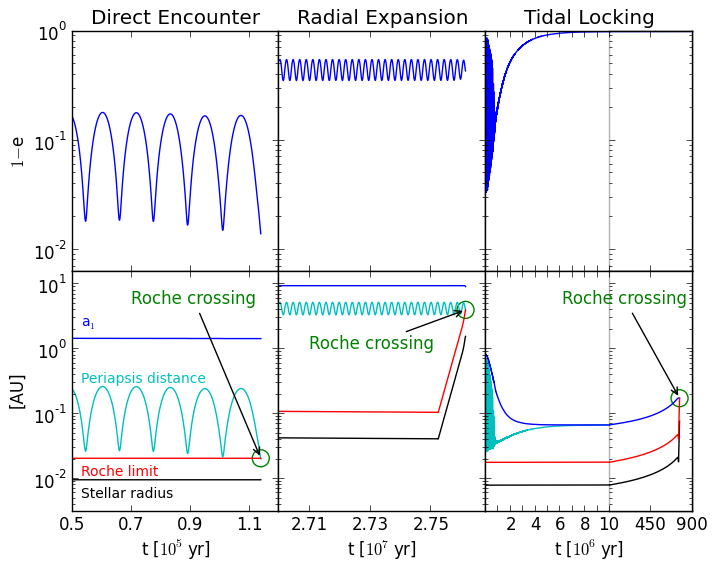Alexander P. Stephan
Field of Research
My research generally revolves around the orbital dynamics of multi-body systems, such as binary and triple stars, compact objects, and exoplanet systems. One focus of my work has been systems for which the Eccentric Kozai-Lidov (EKL) mechanism comes into play. This dynamical effect occurs in hierarchical three-body systems, where two bodies are orbited by a distant third body. In this case the system is stable in the long term, but the eccentricities and inclinations of the orbits can change over time due to the gravitational perturbations from the third body. This can have interesting effects, such as, for example, stellar or planetary collisions or the formation of retrograde orbits (see Naoz 2016 for a full explanation).
I personally am especially interested in the effects that stellar evolution has on the dynamical evolution of these systems. As stars age, they expand and lose mass, becoming red giants, and, depending on their initial mass, end as supernovae, black holes, neutron stars, or white dwarfs, among other possibilities. This can have important effects on these systems by changing the orbital parameters, or, for example, the strength of tides. I have worked to implement these effects into models of the EKL mechanism.
Another focus of my work over recent years has been in the general area of tidal star-planet interactions. In particular, I have investigated the effects that stellar engulfment of Hot Jupiters by evolving stars has on the stellar envelopes, as well as the orbital precession caused by rapidly spinning oblate stars on their close-in planets. Furthermore, I have studied some of the dynamical pathways leading to white dwarf pollution, and the types and compositions of objects that may be accreted. These works help us in understanding some of the internal characteristics of both stars and planets.
Recent Main Research Projects
Nodal Precession of Hot Jupiters
While most stars rotate slowly due to magnetic braking that occurs efficiently in convective stellar envelopes, massive, mostly radiative stars have been observed to rotate rapidly for large parts of their life spans, often being significantly oblate as a result. The distorted shape of such stars can cause significant tidal effects on any closely orbiting object, such as Hot Jupiters, leading to nodal precession of their orbits. Since the speed of the induced precession depends in part on the internal structure and tidal efficiency of the host star,we can probe the internal processes within such stars by measuring the precession speeds over many years of observations. In a recent work I analyzed several years of both archival and new observations of the Hot Jupiters WASP-33b and KELT-9b, confirming the previously observed precession of WASP-33b and measuring for the first time the precession speed of KELT-9b. Both planets precess extremely rapidly, with precession circulation period on the order of 1000 years or shorter; indeed, both planets will not be observable as transits by the end of the
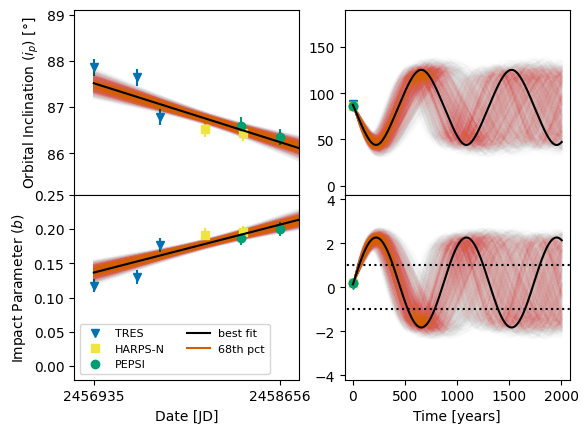
The figure shows the observed values for the impact parameter and planetary inclination for the Hot Jupiter KELT-9b (colored symbols), showing the changes over time in those values. The black line shows the best fit model for the nodal precession derived from the measured values, with the red line showing the 68th percentile uncertainty region of models. The model is extrapolated over the next 2000 years, showing that KELT-9b will cease to transit probably within the current century. Figure taken from Stephan et al. 2022.
century. The work has been published under A.P. Stephan, J. Wang, et al., 2022, Nodal Precession and Tidal Evolution of Two Hot Jupiters: WASP-33 b and KELT-9 b, ApJ, Volume 931, Issue 2, id.111, 12 pp., doi:10.3847/1538-4357/ac6b9a.
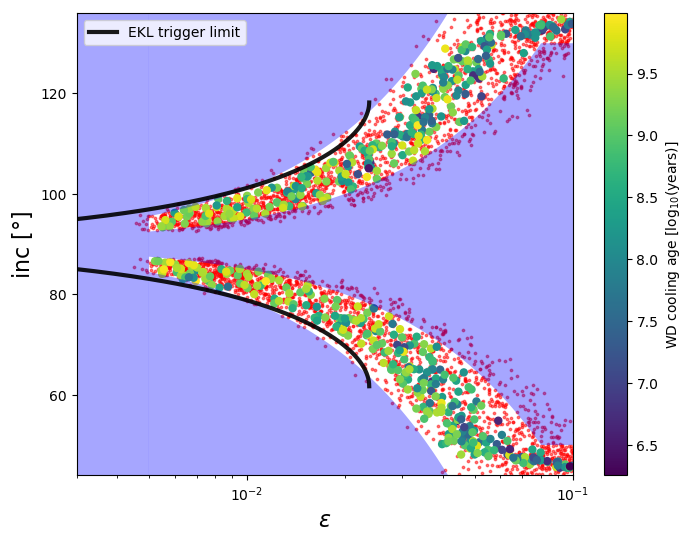
A figure from Stephan et al. 2021 showcasing the parameter space for which mass loss enhances WD pollution and short-period planet formation.
Forming Short-Period Planets around White Dwarfs
Two recently discovered short-period planets around white dwarfs, WD J0914 b and WD 1856 b, have reinforced the notion that planets exist around stars of all stellar evolutionary stages. However, the planets were most likely not formed at their current orbits, but had to migrate there through dynamical interactions. In this recent project, we show that the interplay of stellar evolution and the EKL mechanism can naturally explain the formation of such systems, similar to work we had done in 2017. Crucially, we show that the EKL oscillations can lead to tidal stripping or migration of a giant planet within the first few million years after white dwarf formation, important for explaining WD J0914 b. The paper has been published under A.P. Stephan, S. Naoz, B.S. Gaudi, 2021, Giant Planets, Tiny Stars: Producing Short-Period Planets around White Dwarfs with the Eccentric Kozai-Lidov Mechanism, ApJ, Volume 922, Issue 1, id.4, 9 pp., doi:10.3847/1538-4357/ac22a9.
Effects of Planet Consumption on Evolving Stars
A common outcome of the dynamical evolution of planets in binary star systems is the collision of planets with their host stars due to extreme eccentricity excitations or the engulfment of planets as their host stars evolve into red giants and inflate in radius. These collisions and engulfments can cause a variety of effects on the stars themselves, including stripping of the stellar envelope, changes in the stars' angular momenta and spin rates, luminosity and X-ray radiation spikes, or chemical composition anomalies. As such, if stars that have engulfed their planets can be reliably identified, it would be possible to gain a more complete understanding of the formation and evolution
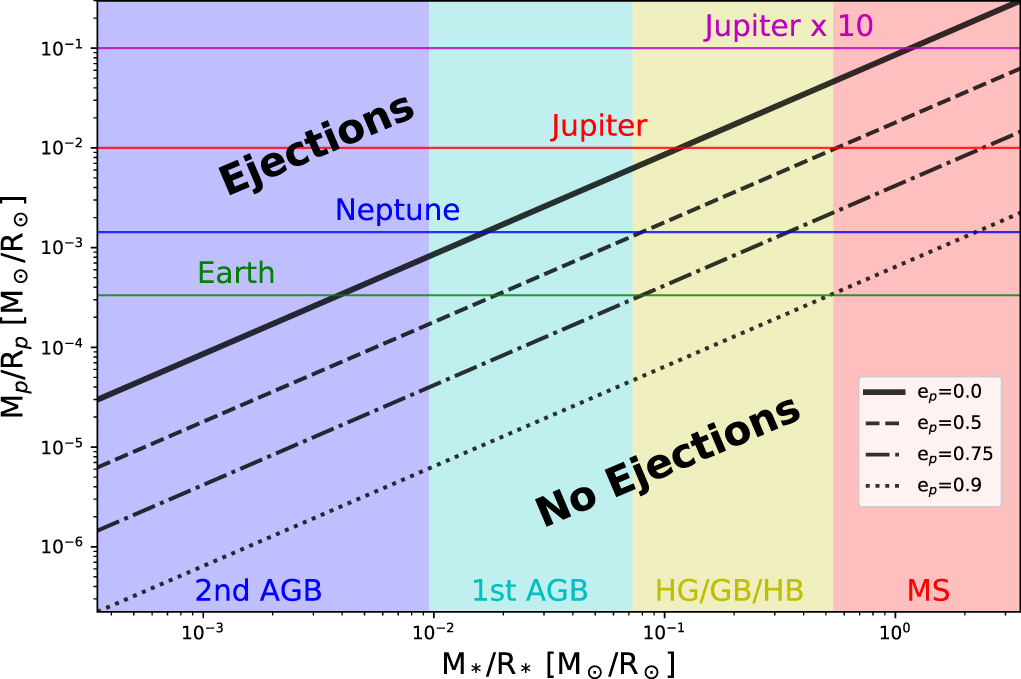
Parameter space showing when surface grazing planets can cause surface eruptions from their host stars, from Stephan et al. 2020.
histories of planetary systems. In my recent paper A.P. Stephan, S. Naoz, B.S. Gaudi, J.M. Salas, 2020, Eating Planets for Lunch and Dinner: Signatures of Planet Consumption by Evolving Stars, ApJ, Volume 889, Issue 1, article id.45, 11 pp., doi: 10.3847/2041-8213/ab21d3 we investigated several of these effects and defined a number of observable features that can help future surveys to identify stars that have recently engulfed their planets. This work was also featured for an article in the New Scientist magazine.

A flowchart from Stephan et al. 2019 outlining the outcomes of binary stellar evolution in the galactic center.
Binary Stellar Evolution in the Galactic Center
My previous work on galactic center binaries from 2016 was mostly focused on the dynamical evolution of such objects up until they either merged or separated into single stars. The exact nature of the resulting "merger products", however, was not well defined in that work. I therefore revisited the topic in 2019 by investigating the binary stellar evolution of merger candidates with a binary stellar evolution code. In this project we showed that binary stars in galactic centers can lead to the formation of a large variety of interesting objects, such as X-ray binaries, type Ia supernovae, cataclysmic variables, as well as black hole and neutron star binaries, and much more. The work shows that galactic centers can be an extremely important location for black hole-neutron star mergers, potentially explaining recent observations by LIGO of such objects. The work was published in A.P. Stephan, S. Naoz, A.M. Ghez, M.R. Morris, A. Ciurlo, T. Do, K. Breivik, S. Coughlin, C.L. Rodriguez, 2019, The Fate of Binaries in the Galactic Center: The Mundane and the Exotic, ApJ, Vol. 878, Issue 1, article id. 58, 7 pp., doi: 10.3847/1538-4357/ab1e4d and has been featured by AAS Nova.
Temporary Hot Jupiters
Hierarchical three-body dynamics has been used as a possible explanation for so-called "Hot Jupiters", giant gas planets that orbit their host stars on short-period orbits (P<10 days), and which are heated to very high temperatures due the close proximity to the star. In this scenario, a giant planet initially orbits its star on a wider orbit, but a companion star or second large planet leads to EKL excitations of the gas giant's orbital eccentricity. As the planet gets closer to the star for part of its orbit, tidal effects become stronger and shrink and circularize the gas giant's orbit, turning it into a Hot Jupiter. However, another way to enhance the strength of tidal effects is to expand the star, such as when it becomes a Red Giant towards the end of its life. I therefore lead a project that investigated the significance of stellar evolution for Hot Jupiter formation in the case of A-type host stars. A-type main-sequence stars have masses about 1.6 to 2.4 times the mass of our Sun and evolve on timescales of about 1 Gyr,
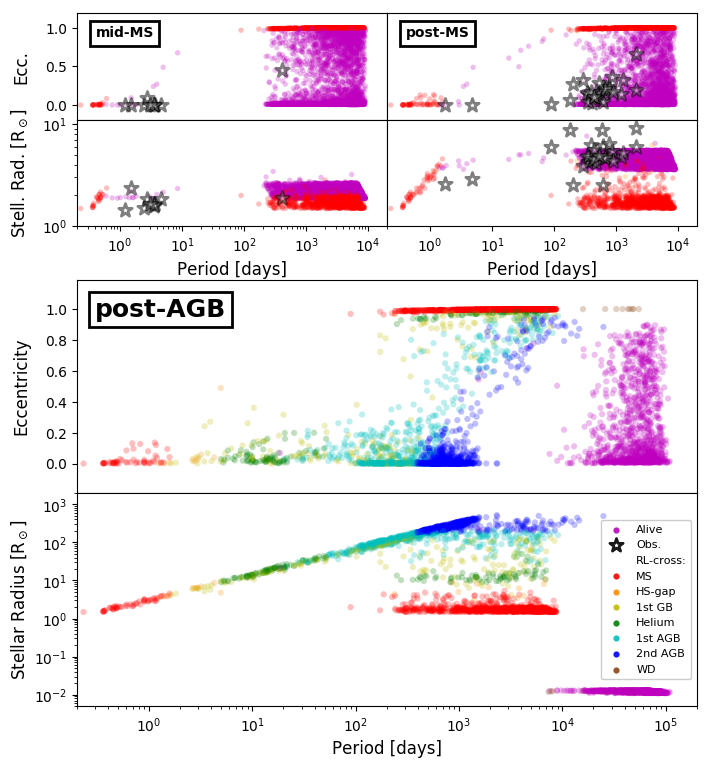
A plot from Stephan et al. 2018 showing the outcomes of gas giant planet dynamical evolution calculation for different stellar lifetimes, and comparing these calculations to observed planets orbiting evolved A-type stars (marked as black stars).
much faster than sunlike stars. They also nearly always possess stellar companions, leading to EKL effects for any planets orbiting either planet. We found that the enhanced tidal effects during the Red Giant phase of the stars can lead to the formation of "Temporary Hot Jupiters", Hot Jupiters that only exist for a few hundred thousand years before they become engulfed by their evolving host star. Overall we found that A-type stars would destroy about 70 % of all gas giant planets orbiting them, by turning them into Hot Jupiters or Temporary Hot Jupiters and subsequently engulfing them. Our work was published in A.P. Stephan, S. Naoz, B.S. Gaudi, 2018, A-type Stars, the Destroyers of Worlds: The Lives and Deaths of Jupiters in Evolving Stellar Binaries, AJ, Vol. 156, Issue 3, article id. 128, 12 pp., doi: 10.3847/1538-3881/aad6e5 and has been featured as a Nature Research Highlight.
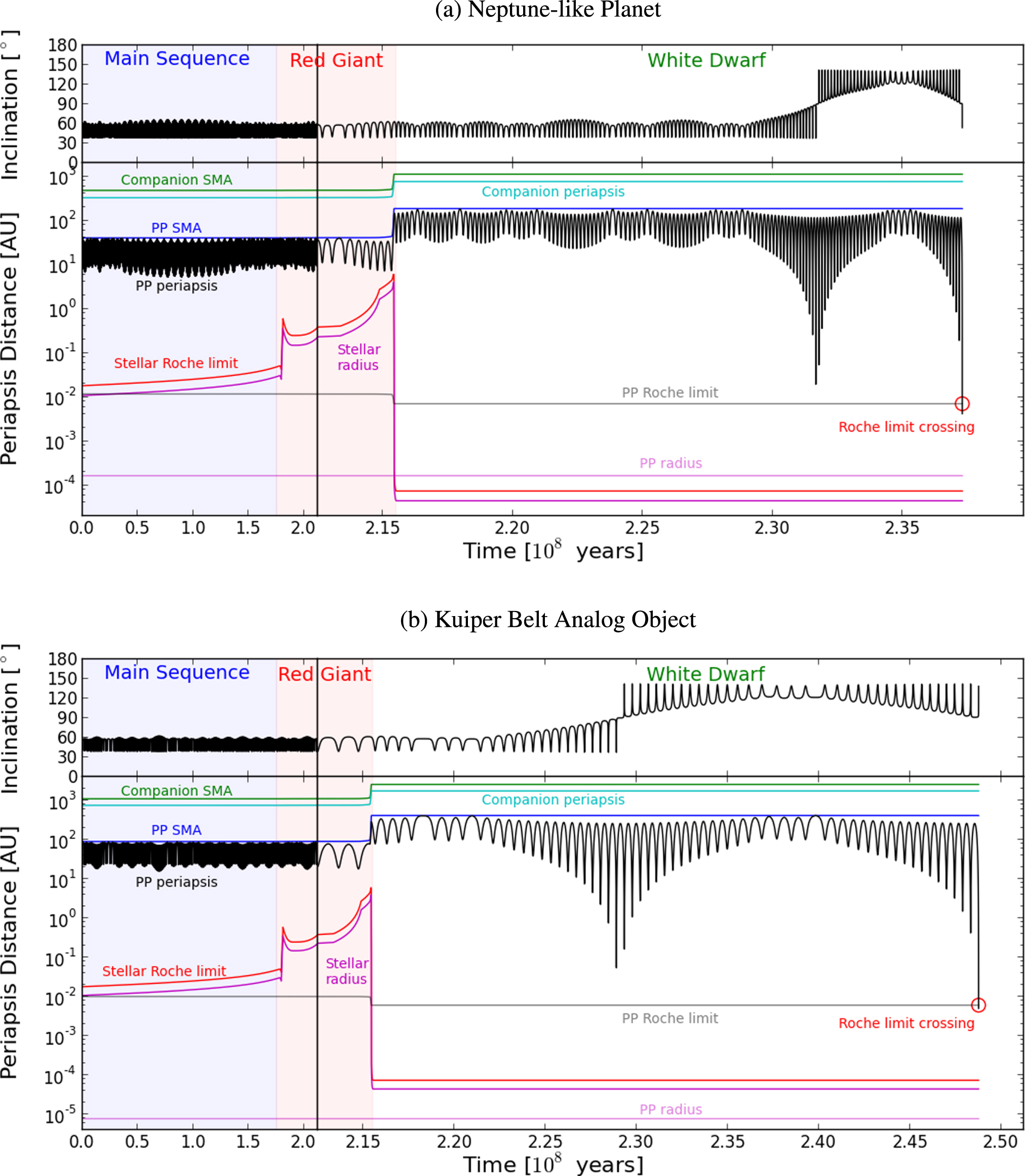
Dynamical evolution of a Neptune-like planet (a) and a Kuiper belt analog object (b) in wide binary star systems. Large eccentricity excitations during the white dwarf phase lead to pollution. [Stephan et al. 2017]
White Dwarf Pollution in Wide Binaries
Some of my previous work has been concerned with the pollution of white dwarfs in evolving wide binary star systems. Over recent decades many studies have revealed that about a quarter to a half of all white dwarf stars, the last life-stage of most stars, contain heavy elements in their atmosphere. However, these elements are expected to sink to the core of the star over short time-scales, indicating that they have been recently polluted by planetary or asteroidal material. In our work, published in A.P. Stephan, S. Naoz, B. Zuckerman, 2017, Throwing Icebergs at White Dwarfs, ApJL, Vol. 844, L16, doi: 10.3847/2041-8213/aa7cf3, we show that some of these white dwarfs can be polluted by planets that orbited far from the star during the main sequence, if they have a stellar companion on a very distant orbit. This is
due to the mass loss that a star undergoes during its evolution, which changes the orbital configuration of the systems and allows the EKL mechanism to become stronger. Thus, objects that did not get destroyed during the main sequence might instead end up coming close to the white dwarf, potentially polluting it. This work perfectly explains recent observations by Xu et al. 2017 that have for the first time found nitrogen pollution in a white dwarf. In our own solar system nitrogen is only abundant in the Kuiper belt, as it is a volatile element. In fact, Earth's atmospheric nitrogen probably came from a Kuiper belt asteroid. The white dwarf in Xu et al. is also part of an extremely wide binary star system, and was therefore most likely polluted by such a Kuiper belt analog object through the EKL mechanism. Our work has also been featured by AAS Nova and Physics Today.
Galactic Center Stellar Binary Dynamics
My Master Thesis project, in collaboration with the UCLA Galactic Center Group, studied the EKL mechanism in the context of binary stars that are orbiting the massive black hole at the center of the Milky Way. For these systems we included the effects of general relativity, tides, and stellar evolution into our calculations, in order to accurately model the possibility of binary mergers in the galactic center. We see a binary merger as a good candidate to explain the G2 object that has been discovered by Gillessen et al. (2012). Our findings were published in:
A.P. Stephan, S. Naoz, A.M. Ghez et al., 2016, Merging Binaries in the Galactic Center: The eccentric Kozai-Lidov mechanism with stellar evolution, MNRAS, Vol. 460, 3494-3504, doi: 10.1093/mnras/stw1220
Other Significant Contributions
The EKL mechanism, including tides and stellar evolution, can be used to study a large variety of different astronomical systems. A project I have been part of was a study by my adviser, Prof. Smadar Naoz, investigating the formation of low-mass X-ray (LMXR) binaries through the EKL perturbations by a third companion. For this study the inclusion of stellar evolution effects, which I assisted with, was of crucial importance. The study was published by ApJ Letters:
S. Naoz, T. Fragos, A. Geller, A.P. Stephan, and F.A. Rasio, 2016, Formation of Black Hole Low-Mass X-Ray Binaries in Hierarchical Triple Systems, ApJ, 822, L24, doi: 10.3847/2041-8205/822/2/L24
Another study I have been involved with was concerned with the stability of multi-planet systems in the presence of an outer companion. In particular, the project considered two planets orbiting a star in a co-planar configuration that are being perturbed by an outer, inclined fourth body, and showed for what configurations such an ensemble would be stable or unstable. The project was lead by a former undergraduate mentee of my adviser and myself, Paul Denham, and was published by MNRAS: P. Denham, S. Naoz, B.-M. Hoang, A.P. Stephan, W.M. Farr, 2018, Hidden Planetary Friends: On the Stability Of 2-Planet Systems in the Presence of a Distant, Inclined Companion, MNRAS, 482, 3, 4146-4154, doi: 10.1093/mnras/sty2830
Sometimes the EKL mechanism can also be used to explain observed exotic stellar phenomena. V Hydrae is a carbon star that shows periodic ejections of gas as highly collimated "bullets" every 8.5 years. It has been suggested that these ejections are caused by the close passage of an eccentric companion during its periastron. However, for such a companion tidal effects are expected to quickly shrink and circularize the orbit, long before the star reaches its current evolutionary stage. In a project by my UCLA graduate student colleague Jesus Salas, on which we collaborated, we show that the continued high eccentricity of the companion can be explained by the existence of a third companion forming a hierarchical triple. We furthermore can set constrains on the mass of the bullet-causing companion (probably a brown dwarf). The project was published by MNRAS: J.M. Salas, S. Naoz, M.R. Morris, A.P. Stephan, 2019, Unseen companions of V Hya inferred from periodic ejections, MNRAS, 487, 3, 3029-3036, doi: 10.1093/mnras/stz1515
Several of my research projects have investigated the evolution of binary stars in the galactic center, to a large part motivated by the observations of dusty objects orbiting Sagittarius A*, such as the so-called G2 object. Past work by the UCLA Galactic Center Group have strongly suggested that such objects are held together by the gravity of a central star, potentially indicating that they are the result of stellar mergers. My dynamical studies have supported that hypothesis, and made predictions that a whole population of such objects should exist in the galactic center, with a large variety of orbital parameters. In a large study led by Dr. Anna Ciurlo, this prediction has been confirmed as a population of six G2-like sources on very different orbits has been identified. The results have been published as a Nature article: A. Ciurlo, R.D. Campbell, M.R. Morris, T. Do, A.M. Ghez, A. Hees, B.N. Sitarski, K.K. O’Neil, D.S. Chu, G.D. Martinez, S. Naoz, A.P. Stephan, 2020, A population of dust-enshrouded objects orbiting the Galactic black hole, Nature, 577, 337–340, doi: 10.1038/s41586-019-1883-y
Current and Future Projects
In general I continue to be interested of the various applications of the EKL mechanism to various astrophysical settings, including exoplanets, stellar remnants, and the galactic center. Future projects will also focus more on the effects of supernova kicks, which introduce short-term changes to a system's orbital configuration that can radically change the dynamical behavior of such systems. These effects are especially relevant for the study of black hole and neutron star binary progenitor systems, which can produce gravitational wave sources relevant for LIGO and LISA. I plan to study the effects on such phenomena in greater detail in the future.
Past Work and Other Research Interests
During my time at the University of Chicago I had the great opportunity to work with Prof. James W. Truran and Michael Florian on problems concerning the chemical evolution of galaxies and dwarf galaxies. While I am not currently working on chemical evolution problems, I continue to be interested in these systems. In particular I wish to further explore the role of galaxy dynamics in these circumstances, at some point.
I also had the great fortune to have had Prof. Michael D. Gladders as my bachelor thesis adviser. The project for my bachelor thesis was concerned with strong gravitationally lensing galaxy clusters and the relation between the brightest cluster galaxy (BCG) mass and the strength of the lens. This was an extraordinarily fascinating project, exploring the structure of galaxy clusters with general relativity.
